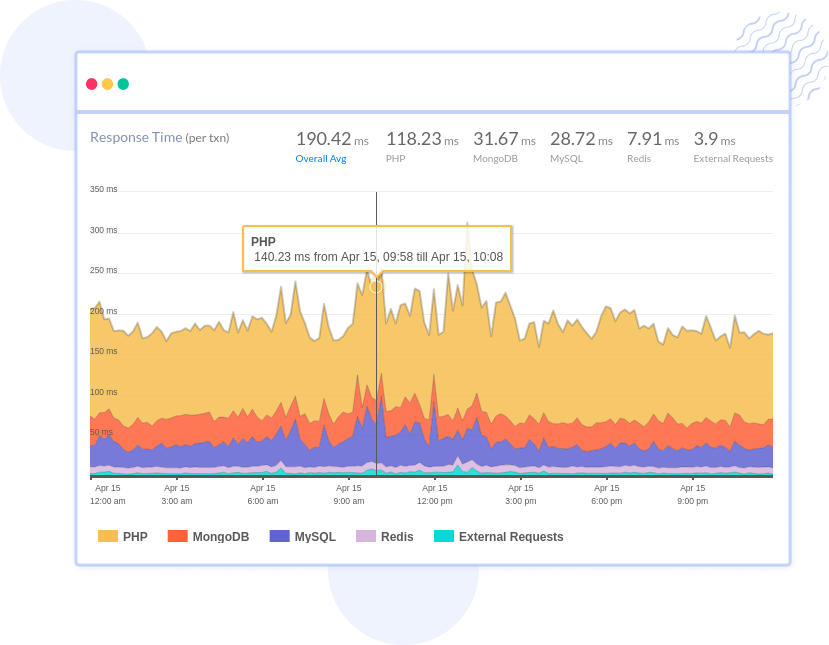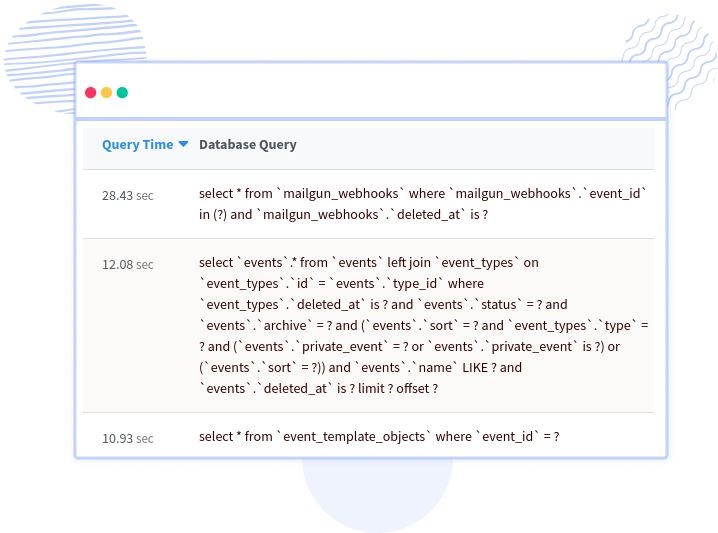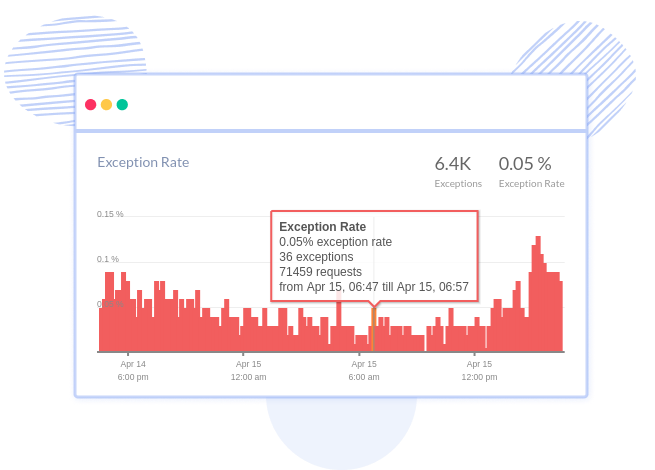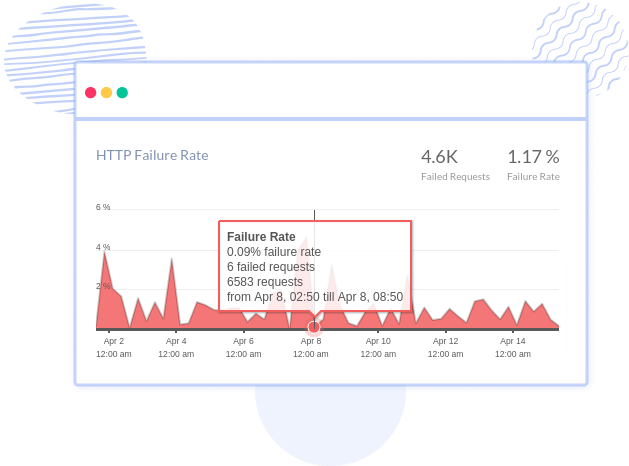Full Stack .NET Performance Monitoring
Get end-to-end visibility into your .NET performance with application monitoring tools. Gain insightful metrics on performance bottlenecks with .NET monitoring to optimize your application.
Get end-to-end visibility into your .NET performance with application monitoring tools. Gain insightful metrics on performance bottlenecks with .NET monitoring to optimize your application.
1. Add the NuGet Atatus package in your application:
# Package Manager
Install-Package Atatus.NetCoreAll -Version 1.0.0
(or)
# .NET CLI
dotnet add package Atatus.NetCoreAll --version 1.0.0
2. Add below initialization code into your Startup.cs file.
using Atatus.NetCoreAll;
public class Startup
{
public void Configure(IApplicationBuilder app, IHostingEnvironment env)
{
app.UseAllAtatus(Configuration);
// Your code here
}
// Your code here
}
3. Add your Atatus configuration in your appsettings.json file.
"Atatus" : {
"APP_NAME" : "YOUR_APP_NAME",
"LICENSE_KEY" : "YOUR_LICENSE_KEY"
}
4. Restart your .NET server.
1. Add the NuGet Atatus package in your application:
# Package Manager
Install-Package Atatus.AspNetFullFramework -Version 1.0.0
(or)
# .NET CLI
dotnet add package Atatus.AspNetFullFramework --version 1.0.0
2. Below is a sample Web.config configuration file for a ASP.NET application.
<?xml version="1.0" encoding="utf-8"?>
<configuration>
<appSettings>
<add key="Atatus:AppName" value=
<add key="Atatus:LicenseKey" value="YOUR_LICENSE_KEY" />
</appSettings>
</configuration>
3. Below is a sample Web.config configuration file for a ASP.NET application.
<?xml version="1.0" encoding="utf-8"?>
<configuration>
<system.webServer>
<modules>
<add name="AtatusModule" type="Atatus.AspNetFullFramework.AtatusModule, Atatus.AspNetFullFramework"/>
</modules>
</system.webServer>
</configuration>
4. Recompile your application and deploy it.
Atatus captures all requests to your .NET applications without requiring you to change your source code. Get a clear picture of how all your methods, database statements and external requests are affecting your user's experience.
Automatically visualize end-to-end business transactions in your .NET application. Monitor the amount and type of failed HTTP status codes and application crash with .NET Monitoring. Analyze response time to identify .NET performance issues and errors on each and every business transaction. Understand the impact of methods and database calls that affects your customer's experience.
Learn more

Examine all SQL and NoSQL queries used by your .NET server. Identify slow database queries and optimize query performance with database monitoring proactively. Monitor and measure third party API calls' response times and REST API failure rates along with HTTP status codes. Slice and dice performance metrics in real time—based on host, version, release stage, URL and other attributes.
Learn more

Every .NET error is tracked using error tracking and captured with full stacktrace and exact line of source code is highlighted to make bug fixing easier. Get all the essential data such as class, message, URL, request agent, version etc to fix the .NET exceptions and errors. Identify buggy API or third party services by investigating API failure rates and application crashes. Get alerts for application errors and exceptions via Email, Slack, PagerDuty, or using webhooks.
Learn more

Quickly view the highest .NET HTTP failures and get each request information along with custom data to identify the root cause of the failures. See the breakdown of the API failures based on HTTP Status Codes and the end-users having the highest impact.
Learn more

Break down slow .NET requests by time spent in code blocks, database queries, external services, templates, message queues and much more. View logs, infrastructure metrics, VM metrics in context with the original request.
Learn more

Try it free. No credit card required. Instant set-up.
Best APM Monitoring tool
— S Herman Kiefus, DevOps Admin, Compass
Analyze your ASP.NET applications and services. Unlock deep insights into .NET performance, enhancing transaction efficiency and swiftly resolving errors.
Visualize end-to-end traces across your stack, ensuring that you catch every .NET error, performance issue, or bottleneck before it affects users.
Pinpoint and resolve slow database queries and eliminate performance bottlenecks impacting your .NET application's responsiveness, leading to faster response times
Get alerted to potential .NET library vulnerabilities, preventing security risks before they affect your customers or compliance.
Centralize all your .NET logs in one place, and quickly identify the root cause of issues using advanced filtering, pattern detection, and log pipelines.
Set up and track custom metrics that align with your app's KPIs to ensure you're monitoring exactly what matters most for your success.
Explore request-level analysis, including stdout APM logs, to understand execution times, bottlenecks, and areas that need optimization.
Correlate your app’s .NET APM metrics with server health to get a complete picture of your application’s performance and infrastructure dependencies.
Receive real-time alerts for .NET app performance degradations and critical issues. Take immediate action to prevent downtime and optimize user experiences.
The .NET performance monitoring tool helps developers to optimize the .NET server performance.
A good .NET APM solution answers the following two questions:
You can easily use application performance monitoring tools to answer, detect and resolve the above issues before they could impact the end users.
In general, there are two types of monitoring:
Every organization should have a well-implemented .NET APM solution, which allows DevOps teams (and the organization as a whole) to resolve issues and performance bottlenecks efficiently and reduce Mean Time To Resolution (MTTR). This has a substantial impact on the bottom line of the business.
Now organizations do not have to deal with the unnecessary work involved in maintaining an extensive software analysis group.
Your .NET performance monitoring tools should be easy to use, offer actionable insights, and be able to:
Check out this blog to know more information - Things You Should Know Before Choosing Application Performance Monitoring Tools.
Technical Benefits:
Business Benefits:
With the help of the database monitoring, you can easily identify the database performance bottlenecks.
Feel assured as we maintain rigorous security protocols, ensuring the safety of your data with every interaction



Avail Atatus features for 14 days free-trial. No credit card required. Instant set-up.